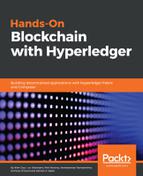Building a complete blockchain application is an ambitious and challenging project, not just because of the range of skills it requires—systems, networking, security, and web application development, to name a few—but because it requires concerted development, testing, and deployment by multiple organizations spanning multiple security domains.
In this chapter, we began with a simple smart contract and ended with a four-peer blockchain network that was ready to drive trade scenarios and store records in a tamper-resistant, shared, replicated ledger. In the process, we learned how to design an organization structure and configure a Fabric network. We learned how to build a channel, or an instance of a Fabric blockchain, get peers in a network to join the channel, and install and instantiate a smart contract on that channel, using the Fabric SDK. We learned how to expose the capabilities of our network and smart contract to end users through web applications, exposing service APIs. We also learned how a Hyperledger Fabric transaction pipeline works, and how the asynchronous nature of block commit operations must be factored into the implementation of the end-to-end application.
In the latter part of the chapter, we learned about various design patterns and best practices that can be used to build industry-scale blockchain applications. We also learned about the considerations to keep in mind while integrating these applications with existing systems and processes. Finally, we explored the performance aspects of running operational Fabric network and learned about the CAP theorem and how Fabric achieves data consistency in distributed environment.
The Hyperledger platforms and tools will, no doubt, evolve over time to serve industry and developer needs, but the architecture and methodology we described in our application-building exercise, as well as the design and integration patterns, should continue to serve as an educational guide in the long term.
Our journey so far has taken us to the foundation of the Hyperledger Fabric framework. We have worked with chaincode and integrated an application using the Fabric SDK API. These are essential skills.
In the next two chapters, we will now explore a different approach to modeling and implementing a business network.
